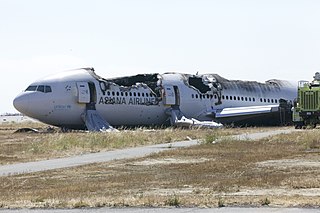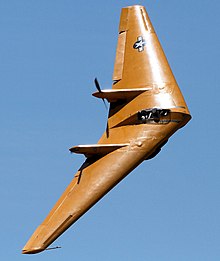
SilkAir Flight 185 was a scheduled international passenger flight operated by a Boeing 737-300 from Soekarno–Hatta International Airport in Jakarta, Indonesia to Changi Airport in Singapore that crashed into the Musi River near Palembang, Sumatra, on 19 December 1997, killing all 97 passengers and 7 crew members on board.

The Northrop N-9M was an approximately one-third scale, 60-foot (18 m) span all-wing aircraft used for the development of the full size, 172-foot (52 m) wingspan Northrop XB-35 and YB-35 flying wing long-range, heavy bomber. First flown in 1942, the N-9M was the third in a lineage of all-wing Northrop aircraft designs that began in 1929 when Jack Northrop succeeded in early experiments with his single pusher propeller, twin-tailed, twin-boom, all stressed metal skin Northrop X-216H monoplane, and a decade later, the dual-propeller N-1M of 1939–1941. Northrop's pioneering all-wing aircraft would lead Northrop Grumman many years later to eventually develop the advanced B-2 Spirit stealth bomber, which debuted in 1989 in US Air Force inventory.

United Air Lines Flight 266 was a scheduled passenger flight from Los Angeles International Airport, California, to General Mitchell International Airport, Milwaukee, Wisconsin, via Stapleton International Airport, Denver, Colorado. On January 18, 1969, at approximately 18:21 PST, the Boeing 727 operating the flight crashed into Santa Monica Bay, Pacific Ocean, about 11.5 miles (18.5 km) west of Los Angeles International Airport, four minutes after takeoff, killing all 38 on board.

Mohawk Airlines Flight 405, a Fairchild Hiller FH-227 twin-engine turboprop airliner registered N7818M, was a domestic scheduled passenger flight operated by Mohawk Airlines that crashed into a house within the city limits of Albany, New York, on March 3, 1972, on final approach to Albany County Airport, New York, killing 17 people. The intended destination airport lies in the suburban Town of Colonie, about 4 miles north of the crash site.

Pan American World Airways Flight 202 was a Boeing 377 Stratocruiser aircraft that crashed in the Amazon Basin about 281 nautical miles southwest of Carolina, Brazil, on April 29, 1952. The accident happened en route from Rio de Janeiro, Brazil, to Port of Spain, Trinidad and Tobago, during the third leg of a four-leg journey. All 50 people on board were killed in the deadliest-ever accident involving the Boeing 377.

Atlantic Southeast Airlines Flight 2311 was a regularly scheduled commuter flight in Georgia in the southeastern United States, from Hartsfield–Jackson Atlanta International Airport to Glynco Jetport in Brunswick on April 5, 1991.

Mineral Wells Airport is a public airport four miles southeast of Mineral Wells, Texas. The National Plan of Integrated Airport Systems for 2011–2015 called it a general aviation facility. It is owned and operated by the city of Mineral Wells. The airport, and the city, lie in Palo Pinto County and Parker County. The terminal is in Parker County.

United Express Flight 6291 was a regularly scheduled United Express flight from Dulles International Airport near Washington, D.C. to Port Columbus International Airport in Columbus, Ohio. It was a service operated by Atlantic Coast Airlines on behalf of United Express.

On April 4, 1955, a United Airlines Douglas DC-6 named Mainliner Idaho crashed shortly after taking off from Long Island MacArthur Airport, in Ronkonkoma, Islip, New York, United States.

On September 16, 2011, The Galloping Ghost, a highly modified North American P-51D Mustang racing aircraft, crashed into spectators while competing at the Reno Air Races in Reno, Nevada, killing the pilot, Jimmy Leeward, and ten people on the ground. Sixty-nine more people on the ground were injured. It was the third-deadliest airshow disaster in U.S. history, following accidents in 1972 and 1951.

Asiana Airlines Flight 214 was a scheduled transpacific passenger flight originating from Incheon International Airport near Seoul, South Korea. On the morning of July 6, 2013, the Boeing 777-200ER operating the flight crashed on final approach into San Francisco International Airport in the United States. Of the 307 people on board, 3 died; another 187 were injured, 49 of them seriously. Among the seriously injured were four flight attendants who were thrown onto the runway while still strapped in their seats when the tail section broke off after striking the seawall short of the runway. It was the first fatal crash of a Boeing 777 since the aircraft type entered service in 1995, and the first fatal crash of a passenger airliner on U.S. soil since the crash of Colgan Air Flight 3407 in 2009. As of 2025, it is the last fatal airliner crash to occur on U.S. soil.

On October 30, 2014, a Beechcraft King Air B200 twin turboprop crashed into a building hosting a FlightSafety International (FSI) training center shortly after taking off from Wichita Mid-Continent Airport in Wichita, Kansas. The pilot, the only person on board, was killed along with three people in the building; six more people in the building were injured.

Dirgantara Air Service Flight 3130 (DIR3130/AW3130) was a scheduled domestic passenger flight operated by Dirgantara Air Service from Datah Dawai Airport, Malinau Regency, East Kalimantan to its provincial capital's airport, Samarinda Temindung Airport, Samarinda, East Kalimantan. On 18 November 2000, the aircraft conducting the flight, a Britten Norman Islander BN-2 sheared tree tops and crashed onto the forest near the airport shortly after takeoff. Search and rescue team immediately found the wreckage of Flight 3130 and the survivors. No one was killed in the crash, but all 18 people on board were injured in the crash; 11 of them were seriously hurt.

On the evening of April 1, 1993, a Swearingen Merlin III twin turboprop, carrying NASCAR champion Alan Kulwicki, crashed near Blountville, Tennessee, while on approach to the nearby Tri-Cities Regional Airport. All four people on board, including Alan Kulwicki, two executives of the Hooters restaurant chain, and the pilot, were killed.

East Coast Jets Flight 81 was a business jet flight operated by East Coast Jets that crashed on July 31, 2008 while attempting a go-around at Owatonna Degner Regional Airport near Owatonna, Minnesota, killing all eight occupants on board. The flight originated in Atlantic City International Airport, and was scheduled to land in Owatonna. The crew made a go-around attempt after the aircraft touched down, but it overran the runway, hit the instrument landing system localizer antenna at an altitude of approximately 5 ft (1.5 m), stalled and crashed, with the main wreckage coming to rest 2,400 ft (730 m) from the runway end.

On 4 August 2018, a de Havilland Canada DHC-2 Beaver aircraft operated by K2 Aviation crashed in poor weather near Denali, Alaska, United States. All five people on board survived the crash, but died before rescuers were able to arrive at the scene. The five people consisted of the pilot and four Polish tourists.

On May 13, 2019, a de Havilland Canada DHC-2 Beaver floatplane operated by Mountain Air Service collided with a Taquan Air de Havilland Canada DHC-3 Turbine Otter floatplane over George Inlet, Alaska, United States. The DHC-2 broke up in mid-air with the loss of all four passengers and the pilot. The DHC-3 pilot was able to maintain partial control – enough to perform a forced landing on George Inlet – but the aircraft sustained substantial damage in the collision and the landing; the pilot suffered minor injuries, nine passengers suffered serious injuries, and one passenger was killed. Both aircraft were conducting sightseeing flights under visual flight rules, which state that the pilot of each aircraft is responsible for visually ensuring adequate separation from other air traffic, commonly known as "see and avoid".

Transair Flight 810 was a Boeing 737-200 converted freighter aircraft, owned and operated by Rhoades Aviation under the Transair trade name, on a short cargo flight en route from Honolulu International Airport to Kahului Airport on the neighboring Hawaiian island of Maui on July 2, 2021. Immediately after an early morning takeoff, one of its two Pratt & Whitney JT8D turbofan engines faltered, and the first officer, who was flying the aircraft, reduced power to both engines. The two pilots—the only occupants of the aircraft—began executing the Engine Failure or Shutdown checklist, but became preoccupied with talking to air traffic control (ATC) and performing other flying tasks, never reaching the section of the checklist where the failing engine was to be positively identified and shut down. The captain assumed control but misidentified the failing engine, increased power to that engine, and did not increase power to the other, properly functioning engine. Convinced that neither engine was working properly and unable to maintain altitude with one engine faltering and the other idling, the pilots ditched off the coast of Oahu about 11 minutes into the flight.


















